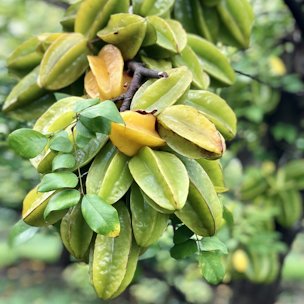Article from
VSCNews, Vegetable and Specialty Crop News
by the American Society of Agronomy
Carambola Could Be the New ‘Star’ of Florida Agriculture
Cover crops may increase sustainability of carambola groves.

Carambola fruit is commonly called star fruit in the United
States. When cut in a cross-section, the slices often look
like stars. The entire fruit is edible.
It’s
not just oranges that grow in Florida. Carambola, or star fruit as most
in the United States call it, is gaining popularity. One researcher
from Florida International University is researching how cover crops
can help the sustainability of star fruit farms.
“Tropical fruit
production has become a prominent practice in Miami-Dade County,” says
Ariel Freidenreich. “For this reason, it is vital that sustainable
farming practices are applied to these systems to ensure healthy soils
and economically viable fruit production.”
“Star fruit are a
great snack while working in the sun because they are juicy and sweet,”
says Freidenreich. “The Arkin variety is the most popular and widely
planted in South Florida. Some growers are now expanding to sweeter and
juicier varieties from Hawaii and other areas. They go great with
salads and are used for juicing. There is even a winery that makes a
delicious star fruit wine (tangy and not too sweet). While these fruits
are not very popular in American culture, they are popular in Asian and
Hispanic cultures, which are very prominent in South Florida.”
Besides being tasty, there’s another reason for finding a variety of crops that grow well in Florida.
“Increasing
the diversity of crops that are grown in various areas is important for
several reasons,” says Freidenreich. “First, crops like oranges are
under pressure from a disease called citrus greening … The disease
destroys the production, appearance and economic value of citrus trees
and their fruit, and there is no cure. Similarly, laurel wilt has been
greatly impacting the avocado industry in South Florida. Different
crops are being planted to replace avocado groves.”
Establishing
crops like star fruit will help diversify the biological system of a
farm. It also diversifies the income stream for growers. Just like a
well-balanced retirement portfolio, balancing the mix of crops on a
farm can reduce overall risk. This is good for the environment and the
sustainability of food sources.
Freidenreich’s research with
carambola includes cover crops. Cover crops are grown not to be
harvested, but to assist with soil health. Two cover crops the team
studied are sunn hemp and velvet bean. Both are in the legume family
and can take nitrogen from the air and metabolize it into a plant
nutrient.
“We established cover crops within this young
carambola stand to enhance overall soil quality,” says Freidenreich.
“We grew sunn hemp and velvet bean between trees. We cut them and
incorporated them into the soil as green manure for two summer growing
seasons. This helps ensure healthy tree development without the
addition of synthetic inputs.”
The research is taking place on a
certified organic farm, and these practices are being developed to help
farmers transitioning to organic production or those interested in
sustainable practices.
Cover cropping should improve the soil
organic matter. “The soil [at the research site] is rock-plowed
limestone with little natural organic matter content,” says
Freidenreich. “These soils have a basic pH, so improving organic matter
content is necessary to help lower pH. This, in turn, should inspire
healthy crop growth.”
Improving soil organic matter “should have
positive effects on soil nutrient availability,” says Freidenreich. “It
should also improve soil structure and microbial interaction. We expect
fruit yield improvement over time. South Florida has a subtropical
climate, so hot and humid weather inspires quick turnover for organic
matter degradation. Continually adding these treatments should have
positive benefits season to season. The cover crops can be great for
weed suppression in the growing season and after termination.”
Future
research means Freidenreich might get to snack on more star fruit while
in the field. “Star fruit are very wind sensitive,” she says. “They can
defoliate with strong gusts. Sunn hemp has the potential to act as a
windbreak for starfruit trees. Additionally, star fruit is truly
tropical and can be sensitive to cool temperatures in the winter months
in subtropical South Florida. Cover crop mulches might insulate the
roots of carambola trees.”
Freidenreich
recently presented her research at the 2019 International Annual
Meeting of the American Society of Agronomy, Crop Science Society of
America and Soil Science Society of America. This research was funded
by U.S. Department of Agriculture-National Institute of Food and
Agriculture- National Needs Graduate and Postgraduate Fellowship Grants
Program (2015-38420-23702) and Florida International University Tropics
Student Grant.
|
|
Bibliography
"Carambola Could Be the New ‘Star’ of Florida Agriculture." Vegetable and Specialty Crop News, 18 Dec. 2019,
vscnews.com/carambola-star-florida-agriculture/.
Accessed 5 Nov 2020.
Photograph
Freidenreich, Ariel. "Carambola fruit is commonly called star fruit in
the United States. When cut in a cross-section, the slices often look
like stars. The entire fruit is edible." Vegetable and Specialty Crop News, 18 Dec. 2019, vscnews.com/carambola-star-florida-agriculture/.
Accessed 5 Nov 2020.
Published 5 Nov. 2020 LR
|
